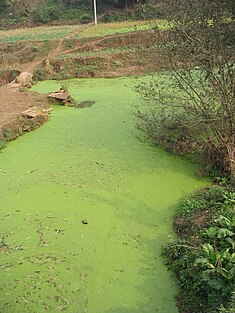
Back Eutrofikasie Afrikaans Eutrofización AN فرط المغذيات Arabic Eutrofización AST Evtrofikasiya Azerbaijani Эўтрафікацыя Byelorussian Еутрофикация Bulgarian Eutrofització Catalan Eutrofizace Czech Ewtroffigedd Welsh

| Part of a series on |
| Plankton |
|---|
 |
Eutrophication is a general term describing a process in which nutrients accumulate in a body of water, resulting in an increased growth of organism that may deplete the oxygen in the water.[1][2] Eutrophication may occur naturally or as a result of human actions. Manmade, or cultural, eutrophication occurs when sewage, industrial wastewater, fertilizer runoff, and other nutrient sources are released into the environment.[3] Such nutrient pollution usually causes algal blooms and bacterial growth, resulting in the depletion of dissolved oxygen in water and causing substantial environmental degradation.[4]
Approaches for prevention and reversal of eutrophication include minimizing point source pollution from sewage and agriculture as well as other nonpoint pollution sources.[1] Additionally, the introduction of bacteria and algae-inhibiting organisms such as shellfish and seaweed can also help reduce nitrogen pollution, which in turn controls the growth of cyanobacteria, the main source of harmful algae blooms.[5]
- ^ a b "Nutrients and Eutrophication | U.S. Geological Survey". www.usgs.gov. Retrieved February 9, 2024.
- ^ Aczel MR (2019). "What Is the Nitrogen Cycle and Why Is It Key to Life?". Frontiers for Young Minds. 7. doi:10.3389/frym.2019.00041. hdl:10044/1/71039.
- ^ "Cultural eutrophication | ecology | Britannica". www.britannica.com. Retrieved February 9, 2024.
- ^ Carpenter SR (2008). "Phosphorus control is critical to mitigating eutrophication". Proceedings of the National Academy of Sciences. 105 (32): 11039–11040. Bibcode:2008PNAS..10511039C. doi:10.1073/pnas.0806112105. PMC 2516213. PMID 18685114.
- ^ "Eutrophication and Oyster Aquaculture in the Potomac River Estuary". NCCOS Coastal Science Website. Retrieved February 9, 2024.